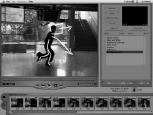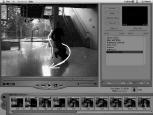|
A Writing Research Associates research project SOFTWARE FOR DANCERS 24 September to 6 October 2001 In collaboration with the Arts Council of England, Sadler's Wells Theatre and Random Dance Company with primary funding from the Dance Department, Arts Council of England |
|
|
original publicity site [click here] | |
|
LETTER 3
[letter 1 / letter 2 / letter 3 / top]28 February 2003
Dear Colleagues,
This is the final update to the Software for Dancers website and it contains links to a number of articles and reports that are not all new, but have just been made available on line.
Software for Dancers is a project that began to come together in my own mind as the fruit of a number of conversations beginning in 1998, but to say it originated with me would be a false statement. These pages which are largely text contain the representation of ideas that are of an open nature; collectively gathered and formulated through different means including editorial which is more where my own voice comes into play.
These new additions to the website mean that the site now contains a written history of a kind of project that began during a certain period in mid 1998. The primary idea was, as the title suggests, to be involved in the development of software for dancers. I feel this project has reached a form of closure; one that is not finished but deserves to find its moment.
 Original proposal: DRAFT VERSION #4 - 13/11/00 - sfddft4.doc
Original proposal: DRAFT VERSION #4 - 13/11/00 - sfddft4.doc
 the Final Report for the Arts Council
the Final Report for the Arts Council
 the Barriedale Operahouse Dialogue
the Barriedale Operahouse Dialogue
 the Isadora Dialogue
the Isadora Dialogue
 the final report for the Celra seminar
the final report for the Celra seminar
 the Monaco Software discussion (transcript)
the Monaco Software discussion (transcript)
Kind Regards,
Scott deLahunta
LETTER 2
[letter 1 / letter 2 / letter 3 / top]25 March 2002
Dear Colleagues,
On 17 February I posted an update letter in which I promised to put the two articles from Software for Dancers on line. They are now available here:
 "Technological Process" by project participant Sanjoy Roy is a lucid and succinct description of the project and includes most of the main conclusions reached by the research team. This article was published in the most recent issue of Dance Theatre Journal, Vol. 17: No. 4 (contact Dance Theatre Journal through the Laban Centre website: http://www.laban.co.uk for a copy of the issue).
"Technological Process" by project participant Sanjoy Roy is a lucid and succinct description of the project and includes most of the main conclusions reached by the research team. This article was published in the most recent issue of Dance Theatre Journal, Vol. 17: No. 4 (contact Dance Theatre Journal through the Laban Centre website: http://www.laban.co.uk for a copy of the issue).
 "Software for Dancers: Coding Forms" was written by myself and accepted for publication in the upcoming *Translations* issue of the Journal of Performance Research. This essay engages with the question "what is software?" as a reflection on and extension of the Software for Dancers project and, as one of the outcomes of the project, aims to contribute to a growing area of study of software as a condition and shaper of cognition, creativity and culture.
"Software for Dancers: Coding Forms" was written by myself and accepted for publication in the upcoming *Translations* issue of the Journal of Performance Research. This essay engages with the question "what is software?" as a reflection on and extension of the Software for Dancers project and, as one of the outcomes of the project, aims to contribute to a growing area of study of software as a condition and shaper of cognition, creativity and culture.
In addition, the final report on the International Think Tank on "New Performance Tools: Technologies / Interactive Systems" is on line here: http://www.dance.ohio-state.edu/workshops/ttreport.html. The Think Tank (25-27 January 2002), organised by Johannes Birringer in Columbus, Ohio, under the umbrella of the new “Interactive Performance Series” in OSU’s Dance and Technology program, brought together a small group of professional artists with established practices to explore the practical and conceptual implications of working with interactive tools, instruments and computer-controlled systems within performance conditions and exhibition-installation contexts.
the final report on the International Think Tank on "New Performance Tools: Technologies / Interactive Systems" is on line here: http://www.dance.ohio-state.edu/workshops/ttreport.html. The Think Tank (25-27 January 2002), organised by Johannes Birringer in Columbus, Ohio, under the umbrella of the new “Interactive Performance Series” in OSU’s Dance and Technology program, brought together a small group of professional artists with established practices to explore the practical and conceptual implications of working with interactive tools, instruments and computer-controlled systems within performance conditions and exhibition-installation contexts.
I would also like to point you in the direction of Mark Coniglio's (Troika Ranch) programme Isadora that is now available for download from this site: http://www.troikaranch.org/troikatronix/isadora.html. This programme provides a user friendly interface that enables you to work with digital media synthesis (video, sound, text and graphics). It's not only a fantastic programme for teaching yourself about cross media synthesis and interactive real time control of media, but is also a highly functional performance tool. Currently, it's available for Macs, but Mark is working on a PC version.
Mark Coniglio's (Troika Ranch) programme Isadora that is now available for download from this site: http://www.troikaranch.org/troikatronix/isadora.html. This programme provides a user friendly interface that enables you to work with digital media synthesis (video, sound, text and graphics). It's not only a fantastic programme for teaching yourself about cross media synthesis and interactive real time control of media, but is also a highly functional performance tool. Currently, it's available for Macs, but Mark is working on a PC version.
There will be more materials posted here in the future, including a report on the premiere performances of Duplex in Frankfurt 6 and 7 March, which utilised Barriedale Operahouse's software ChoreoGraph: choreography by Michael Klien, music by Volkmar Klien and programming by Nick Rothwell.
Kind Regards,
Scott deLahunta
LETTER 1
[letter 1 / letter 2 / letter 3 / top]17 February 2002 (from London)
Dear Colleagues,
It is now more than four months since the public seminar on 6 October 2001 at the Clore Studio, Royal Opera House, London to present the results of the research project "Software for Dancers". To jog your memories, "Software for Dancers: tools to support the choreographic process [phase one]"; was a London-based action research project organised as a collaboration between Writing Research Associates, the Arts Council of England's Dance Department, Sadler's Wells Theatre and Random Dance Company. It aimed to develop concepts for new software tool(s) to support and augment the choreographer’s creative process and to use this focus to provide the stimulus to reflect critically on the: (1) recognition and transformation of materials and methods in the process of art making, whether computational or choreographic; (2) conditions for collaborations between choreographers and digital artists / programmers. The primary research team comprised London based choreographers Siohban Davies, Shobana Jeyasingh, Wayne McGregor and Ashley Page working in collaboration with digital artists/ programmers from the UK and Germany: Guy Hilton, Jo Hyde, Bruno Martelli, Adrian Ward and Christian Ziegler. Two researcher/ writers, Sanjoy Roy and Saul Albert, also participated. I was the project co-ordinator/ facilitator.
This announcement is to bring you up to date with the outcomes of the project thus far. The public seminar on 6 October, the first tangible outcome of the project, was meant to share these concepts for new software tool(s) with people interested in deepening their understanding of how digital media processes and practices can support choreographic creativity at various stages. The seminar was attended by approximately forty-five individuals and included additional presentations from three artist groups developing software tools for use in rehearsal and live performance: Troika Ranch (New York City), Barriedale Operahouse (Vienna and London) and Igloo (London).
In the period since the seminar, two articles stemming from the project have been written: one of them, "Technological Process", by project participant Sanjoy Roy is a lucid and succinct description of the project and includes most of the main conclusions reached by the research team. This article was published in the most recent issue of Dance Theatre Journal, Vol. 17: No. 4 (contact Dance Theatre Journal through the Laban Centre website: http://www.laban.co.uk/ for a copy of the issue). A second article, "Software for Dancers: Coding Forms" was written by myself and accepted for publication in the upcoming *Translations* issue of the Journal of Performance Research. This essay engages with the question "what is software?" as a reflection on and extension of the Software for Dancers project and, as one of the outcomes of the project, aims to contribute to a growing area of study of software as a condition and shaper of cognition, creativity and culture.
The third and final outcome from the project will be an overall report to include a list of proposals to be considered for the next stage of development (recommendations for phase two). This is being currently drafted as a report for the Dance Department, Arts Council of England and will include references to a parallel initiatives such as the premiere of Duplex in Frankfurt 6 and 7 March, the Barriedale Operahouse project involving the software *ChoreoGraph*, and the upcoming release of *Isadora* Mark Coniglio's (Troika Ranch) software facilitating real time interactive control and cross synthesis of media in rehearsal and performance. There will also be references to the interdisciplinary Think Tank that just took place at Ohio State University on 25-27 January 2002 on "New Performance Tools: Technologies / Interactive Systems". This project was organised under the umbrella of the new "Interactive Performance Series" at OSU's Dance and Technology program. Its aim was to bring together a small group of professional artists with established practices to explore the practical and conceptual implications of working with interactive tools, instruments and computer-controlled systems within performance conditions and exhibition-installation contexts. There will soon be a comprehensive report of that project on line.
This website: http://huizen.dds.nl/~sdela/sfd, currently contains and will continue to maintain the original publicity site from the first phase (which includes for example early prototype descriptions under 'real time documentation'), but in addition will soon house the two articles mentioned above as well as links to the OSU Think Tank and eventually the final report with the list of proposals being considered for further development, etc.
Kind Regards,
Scott deLahunta
---------------------------------------------------==|
---------------------------------------------------==|
Scott deLahunta
Writing Research Associates, NL
Sarphatipark 26-3, 1072 PB Amsterdam, NL
mobile: +44 (0)797 741 2060 [messages too]
fax: +44 (0)845 334 2931
email: sdela@ahk.nl
www: http://huizen.dds.nl/~sdela/
---------------------------------------------------==|
---------------------------------------------------==|





